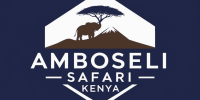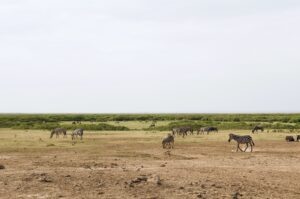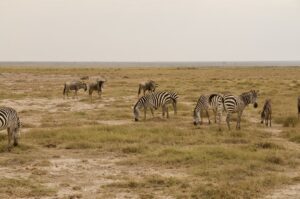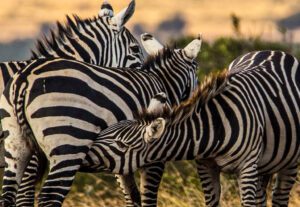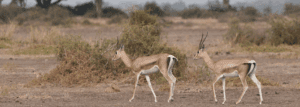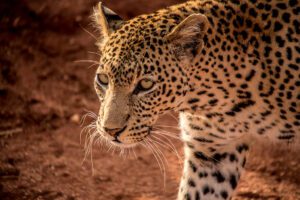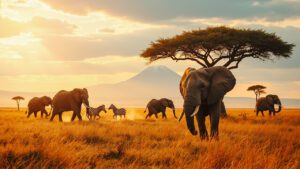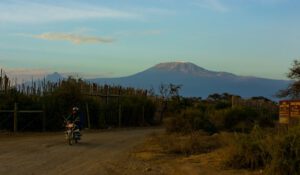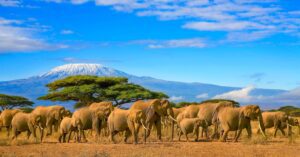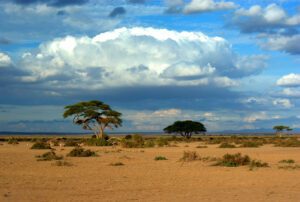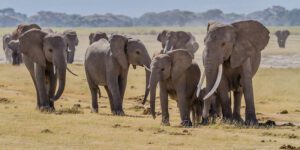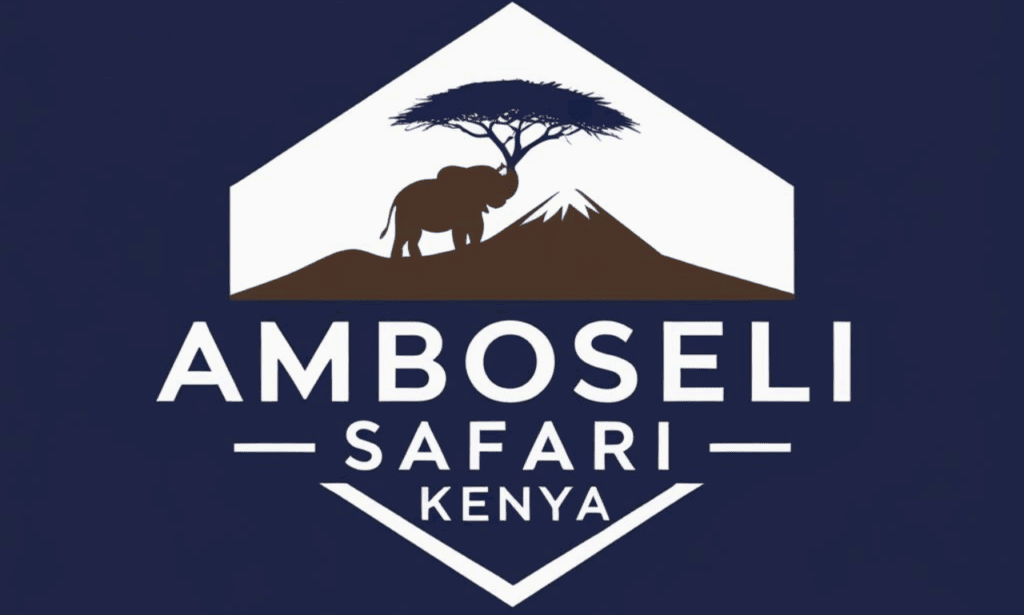Where is Kimana Reserve located?
Kimana Reserve is located in Kenya, East Africa, near the famous Amboseli National Park and is a part of the larger Amboseli ecosystem, which serves as an important wildlife corridor connecting Amboseli National Park to other natural reserves like Tsavo West National Park and Chyulu Hills National Parks. This corridor is vital for wildlife movement, especially for abundant wildlife such as elephants, which migrate across these protected areas. The stunning views of Mount Kilimanjaro towering in the background enhance the beauty of Kimana Reserve, making it a truly wonderful place to explore.
Managed by the local Maasai community, Kimana plays a crucial role in conserving the natural environment and protecting its wildlife. This community-operated wildlife sanctuary offers a more serene, less crowded alternative to Amboseli, making it a popular choice for safari enthusiasts. The combination of breathtaking scenery, incredible wildlife, and cultural significance makes Kimana Reserve an essential stop for those seeking to experience the rich biodiversity of Kenya.
Visitors to Kimana can enjoy the beautiful environment while observing relaxed animals in their natural habitat. The reserve is easily accessible, providing a gateway to the surrounding wilderness camp areas and local villages, where travelers can immerse themselves in the unique culture of the Maasai people. With its rich ecosystem and community involvement, Kimana Reserve is a prime example of how conservation and tourism can go hand in hand.
How do I get to Kimana Reserve?
Getting to Kimana Sanctuary depends on where you’re starting from, but most visitors typically travel from Kenya’s capital city, Nairobi. By road, Kimana is about 200 kilometers (around a 4-5 hour drive) southeast of Nairobi. The route is straightforward – you can drive along the Nairobi-Mombasa highway before branching off toward Kimana. This journey offers views of the beautiful environment typical of the Tsavo West National Park region.
If time is a concern, flying is an option. Several domestic airlines operate flights from Nairobi’s Wilson Airport to the nearby Amboseli airstrip, a short drive from Kimana Reserve. From the airstrip, you can arrange for a transfer to the reserve; many safari tour companies or lodges in the area can organize this for you, ensuring you experience the abundant wildlife.
If you’re already exploring the popular Amboseli National Park, reaching Kimana Reserve is very convenient. It’s just a short drive from Amboseli, making it a perfect day trip or an additional stop within your safari itinerary to enjoy the relaxed animals.
For those not keen on self-driving, most travel agencies in Nairobi or even internationally offer full safari packages to Kimana that include transportation, guides, and accommodation. If you’re feeling adventurous and opt for public transport, it’s possible to take a bus or matatu (shared taxi) toward the town of Kimana, located near the reserve. From the town, you’d need to hire a local taxi or arrange transport to the entrance of the reserve.
What wildlife can I expect to see at Kimana Reserve?
Kimana Reserve is home to an incredible variety of wildlife, making it a paradise for nature lovers and photographers. It plays host to iconic African animals like elephants, zebras, giraffes, buffaloes, and lions. In particular, elephants are a highlight of Kimana. They’re often seen in large herds, with the majestic backdrop of Mount Kilimanjaro creating incredible photo opportunities.
You’ll also find antelopes like impalas and gazelles grazing in the open plains. Predators such as cheetahs, hyenas, and leopards may also make an appearance if you’re lucky or patient, as they are more elusive. Another big draw for visitors is the wealth of birdlife. The reserve is an excellent location for birdwatching, with over 400 bird species recorded. Examples include ostriches (yes, the big, flightless birds!), weaverbirds, flamingoes, and different types of eagles and kingfishers.
What makes Kimana special is that it serves as a wildlife corridor for many animals migrating between nearby parks like Amboseli and Tsavo. This means that depending on the time of year, you might see unique animal movements and interactions as they travel through the area.
The reserve’s smaller size compared to other parks also increases the chances of seeing wildlife up close since animals are concentrated in one area. For example, you might see elephants drinking at watering holes or spot lions lying under acacia trees. Whether you’re a first-timer or an experienced safari-goer, Kimana’s diversity promises an unforgettable wildlife experience!
What is the best time of year to visit Kimana Reserve?
The best time to visit the Kimana Sanctuary is during the dry season, which typically runs from late June to October and from late December to February. During this time, the weather is more predictable, with sunny skies and minimal rainfall. This makes it easier to navigate the reserve’s roads and enhances your overall wildlife-viewing experience in this wonderful place.
In the dry season, animals in Kimana Reserve tend to gather around water sources, such as rivers, streams, or watering holes, as these become the primary spots for hydration. This makes it much more convenient for visitors to spot a variety of animals in one place, including elephants, zebras, wildebeests, and gazelles. For example, imagine spotting a herd of tusker elephants bathing or a group of antelopes grazing near a waterhole, these are common scenes in this season.
On the downside, if you visit during the wet season (March to May or November), you’ll encounter more lush green landscapes and blooming vegetation. While this makes everything look beautiful and vibrant, it can also make animal spotting more challenging as wildlife tends to scatter across the larger landscape where food and water are abundantly available. Additionally, the wet season can bring muddy and slippery roads, which might make accessing some areas of the reserve more difficult.
If you’re a bird enthusiast, though, the wet season might actually be a great choice, as migratory birds arrive in the reserve during this time, making it a birdwatcher’s paradise. So while the dry season is generally considered the best for wildlife viewing, the “best” time may also depend on your personal interests, whether that’s big game or stunning landscapes.
Are guided tours available in the reserve?
Yes, guided tours are absolutely available in Kimana Sanctuary. In fact, they are highly recommended, especially if you’re visiting for the first time or want to ensure a comprehensive and safe experience. Guided tours are typically led by professional guides or rangers who have a deep understanding of the sanctuary’s ecosystem, wildlife, and terrain.
These tours come in various forms, ranging from half-day excursions to full-day or multi-day safaris. A guide can take you to the best spots for viewing wildlife, share interesting facts about the different species, and even point out animals you might not have noticed on your own. For instance, a guide might help you spot a well-hidden leopard resting on a tree or explain the unique behaviors of a specific bird.
Another advantage of guided tours is that they usually come with proper vehicles and equipment designed for game viewing, such as open-roof safari trucks. This enhances your experience and ensures you can capture great photos. Guided walking safaris are also available for those who want to explore certain areas on foot, while being safely accompanied by a trained ranger.
Many guided tours also include extras, like cultural interactions with local Maasai communities, where you can learn about their traditions, see traditional dances, and understand their way of life. Guided tours not only enrich your experience but also support local guides and help contribute to conservation efforts, as many tour fees are reinvested into protecting the reserve and its environment.
Be sure to book tours in advance, as they can fill up quickly during peak tourist seasons. Whether you prefer a private guided tour or a group safari, there’s an option for everyone.
What are the accommodation options near or within Kimana Reserve?
Visitors to Kimana Reserve have several accommodation options to choose from, ranging from luxurious lodges to more budget-friendly campsites. The type of accommodation you select will depend on your budget, preferences, and desired proximity to the reserve.
For those seeking comfort and luxury, there are several high-end safari lodges located near the reserve. These lodges often provide stunning views of Mount Kilimanjaro and offer amenities like spacious rooms, gourmet dining, swimming pools, and guided game drives. Examples include Amboseli Serena Safari Lodge and Tawi Lodge, both of which are just a short drive away from Kimana Reserve. Staying in these lodges provides a relaxing experience while ensuring easy access to the reserve.
If you’re looking for something more budget-friendly, there are several mid-range tented camps and budget lodges near the reserve. These provide basic but comfortable accommodations and allow you to enjoy the African wilderness without breaking the bank. Options like Kimana Camp and Kibo Safari Camp provide a blend of affordability and convenience, often located right on the fringes of the park.
For the more adventurous traveler, camping is also a popular option. There are designated campsites near the reserve where visitors can set up their own tents or take advantage of pre-arranged camping facilities. Camping allows for a closer connection to nature and is a great choice for backpackers or those seeking a minimalist experience.
Regardless of your choice, it’s important to book your accommodations ahead of time, especially during peak seasons, as spots fill up quickly. Most accommodations can also help arrange guided tours, making it even easier to plan your visit to the reserve.
What activities can visitors engage in at Kimana Reserve?
At Kimana Sanctuary, visitors can enjoy a variety of activities that bring them closer to nature and wildlife. One of the most popular activities is game drives. These guided tours in safari vehicles take you around the reserve to spot animals like elephants, lions, zebras, giraffes, and more. Game drives are often done early in the morning or in the evening because animals are more active during these cooler times of the day. Some companies even offer night drives, where you can use spotlights to find elusive nocturnal animals like leopards or hyenas.
Another favorite activity is birdwatching. Kimana Sanctuary is known for its many bird species, including flamingos, hornbills, eagles, and colorful bee-eaters. If you’re a photography lover, birdwatching and game drives offer excellent opportunities to capture stunning wildlife photos, especially with majestic Kilimanjaro towering in the background.
For those who enjoy walking rather than driving, there are guided nature walks, where trained safari guides explain local plants, animal tracks, and even insect life. It’s a more personal way to experience the environment and learn about the ecosystem.
Some visitors also enjoy visiting the sanctuary for picnics or spending time in the serene natural surroundings. There are designated areas where you can safely relax amidst the beauty of the African savannah.
Lastly, Kimana Sanctuary is not just about wildlife, it’s part of the Amboseli ecosystem, so some tours integrate a visit here with surrounding areas. You could combine your trip with larger attractions like Amboseli National Park or other community-run conservancies nearby.
Overall, activities at Kimana Sanctuary cater to all kinds of adventurers, whether you’re looking for thrilling wildlife encounters, peaceful moments in nature, or educational experiences.
Are there any cultural experiences or interactions with local communities offered in the area?
Yes, visitors to the Kimana sanctuary have the opportunity to engage with the local Maasai community, which has lived in the area for centuries. The Maasai are a semi-nomadic people known for their colorful clothing, beadwork, and unique traditions. By visiting Maasai villages around the sanctuary, you can learn about their way of life, culture, and history.
One common cultural experience is a village visit, where the Maasai welcome guests into their homes, called manyattas. They’ll share how these traditional homes are built using natural materials like mud and sticks, allowing you to see firsthand how families live in harmony with the beautiful environment. You might also participate in their daily activities, such as milking livestock or herding cattle.
Another highlight of Maasai culture is their traditional dances and songs. During your visit, the Maasai may perform their famous jumping dance, called the “Adumu,” where men leap into the air as a show of strength and endurance. Often, women participate by singing rhythmic and melodic songs in the background.
You can also learn about their crafts by watching or purchasing handmade beadwork like necklaces, bracelets, and earrings. This beadwork often has cultural significance, with each color and pattern symbolizing something about the Maasai’s beliefs, life stages, or identity. Buying these items directly benefits local families.
Cultural interactions aren’t just about observing, they’re also about connecting. Many of the community-run reserves around the Kimana campsite, including Kimana Reserve itself, value conservation through collaboration. The revenue from your visit often goes toward education, healthcare, and conservation initiatives that benefit both the people and the wildlife. By engaging in these cultural experiences, you’re directly contributing to the community’s wellbeing.
How large is the reserve, and how much time is needed to explore it fully?
Kimana Reserve covers approximately 16,700 acres (around 67 square kilometers) of protected land within the larger Amboseli ecosystem. While it’s not as massive as larger parks like Amboseli National Park or Tsavo West National Park, it’s still quite significant because it acts as a wildlife corridor, that means animals like tusker elephants use it to move between different areas safely. This wildlife sanctuary is essential for preserving the region’s biodiversity.
Given Kimana’s size, you don’t need several days to explore it fully. Many visitors can comfortably explore the reserve within a day or two, depending on their schedule and interests. A single full-day game drive or two half-day game drives (one morning and one evening) would allow you to see most of the reserve and spot its key wildlife and bird species like the elusive leopard and giraffe. If you enjoy taking your time for photography, birdwatching, or nature walks, then staying for two days is ideal.
However, since Kimana connects to larger ecosystems, many travelers choose to combine their visit with nearby destinations like Amboseli National Park. Amboseli is famous for its huge elephant herds and breathtaking views of the majestic Kilimanjaro towering in the background. Spending 3-5 days in the area allows you to enjoy both Kimana and the surrounding parks without rushing.
It’s also important to factor in travel time to and from the reserve. If you’re staying in nearby accommodations, like a lodge or lakeside camp, travel to Kimana is convenient, but if you’re coming from places farther away (e.g., Nairobi), you may need extra travel days.
In summary, Kimana Reserve is not overwhelmingly huge, and you can explore its main attractions in about a day or two. That said, pairing it with visits to other parts of Amboseli ensures a richer, more complete experience in this beautiful environment.
Are there any rules or restrictions visitors should be aware of in the reserve?
When visiting Kimana Reserve, it’s important to follow specific rules and guidelines to ensure the safety of both visitors and wildlife, as well as to preserve the environment. Here are some of the key rules and restrictions you should be aware of:
- Do Not Litter: Kimana Reserve is a protected area, and leaving trash behind can harm animals and the environment. Visitors are encouraged to carry their waste with them and dispose of it properly in designated areas outside the reserve.
- Stay Silent and Respect Wildlife: Animals in the reserve live in their natural habitat. Loud noises can disturb them or provoke aggression. Visitors should remain quiet and observe animals from a safe distance. You should never try to feed or touch the animals.
- Stick to the Path/Eco-Trails: Visitors are required to stay on designated roads and paths. Driving off-road can damage the environment and disturb animal habitats. Guides will often emphasize this rule during tours.
- Follow the Instructions of Guides: If you’re part of a guided tour, the guide knows the reserve’s rules and how to stay safe. Always listen to their advice, including where you can go and what you can or cannot do.
- Vehicles and Speed Limits: Vehicles must stay within the appropriate speed limit, typically around 40 km/h, to avoid accidents with both wildlife and people.
- No Harassing Animals: Visitors are prohibited from chasing animals or trying to get too close for photos. Respect their space, this is their home. For example, a curious visitor trying to get close to an elephant could end up in a dangerous situation, as these animals can feel threatened easily.
By respecting these rules, you’re helping protect the delicate ecosystem of Kimana Reserve.
What is the significance of Kimana Reserve in terms of ecology and conservation?
Kimana Reserve plays a crucial role in ecology and conservation, particularly because of its unique location and its importance as a wildlife corridor. Located in southern Kenya, it lies near Amboseli National Park, Mount Kilimanjaro, and several other wildlife areas. Here’s why that matters:
- Wildlife Migration Corridor: Kimana is part of a vital migration route. Wildlife doesn’t just stay within parks, they often need to move between regions to find food, water, or breeding grounds. Kimana connects Amboseli National Park to Tsavo and Chyulu Hills, allowing species like elephants, zebras, and wildebeests to migrate safely. Without Kimana Reserve, these animals could face more human-wildlife conflict in their search for resources.
- Conservation of Wetlands: The reserve is home to wetlands, including springs and marshes that provide fresh water, especially during dry seasons. These water sources are critical not only for wildlife but also for local communities and cattle herders.
- Protection of Biodiversity: Kimana supports a wide range of animals, such as lions, giraffes, cheetahs, and bird species. By protecting the reserve, authorities are ensuring that these species continue to thrive without being threatened by hunting, poaching, or habitat destruction.
- Community Conservation Model: Kimana is one of Kenya’s community-managed reserves. This means that local Maasai communities play a direct role in managing and benefiting from the reserve. Eco-tourism revenue supports education, healthcare, and other services in the area, creating an incentive to protect the environment and reduce hunting or other destructive practices.
In essence, Kimana Reserve isn’t just protecting land or animals. It’s maintaining a delicate balance between wildlife, local communities, and the natural environment. For example, an elephant migrating safely through Kimana to Amboseli National Park represents how conservation efforts come full circle in benefiting species and people alike.
What is the cost of visiting and exploring Kimana Reserve, including entrance fees and other expenses?
The cost of visiting Kimana Reserve can vary depending on factors like whether you’re a local (Kenyan citizen) or a tourist, as well as the activities you plan to engage in and the accommodations you choose.
- Entrance Fees: Entrance fees to reserves in Kenya often have different rates for Kenyan citizens, residents, and international visitors. For instance:
- Kenyan citizens might pay around 500–1000 Kenyan Shillings per adult.
- Residents can expect slightly higher fees (e.g., 1000–2000 KSH).
- International tourists, however, usually pay in U.S. dollars. You may need to pay somewhere between $20–$30 per adult.
Children often get discounted fees, and there may also be separate charges for vehicles entering the park.
- Guided Tours and Activities: If you hire a guide for a game drive or other activities, it will add to the costs. Safari tours can range from $50–$200 depending on the length of the trip and the type of vehicle hired (such as a 4×4 Land Cruiser).
- Accommodation: Accommodations near Kimana Reserve include basic campsites, modest lodges, and luxurious safari camps.
- Budget accommodations, like camping or small guesthouses, can cost somewhere between $20–$50 per night.
- Mid-range lodges might charge $100–$250 per night.
- High-end lodges or “glamping” safari camps can go up to $500 or more.
- Additional Expenses: Other costs include transportation to and from Kimana Reserve. If you’re coming from Nairobi, you might hire a private car or join a tour group. Transportation could cost anywhere from $50–$150. Meals, snacks, and tips for guides or staff should be factored in, too.
For instance, if you’re an international tourist doing a mid-range safari with two nights of accommodation, guided tours, and transportation, you might spend around $500–$800 for the trip. On the other hand, a local resident on a budget might spend $50–$100 for a day trip.
Make sure to check with your tour operator or lodge for the most updated fees, as rates may change depending on the season or management.
